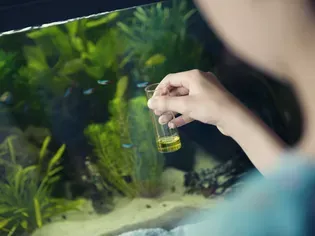How Do Fish Get Parasites?
Updated on 04/26/24

Unveiling the Intriguing Mystery: How Do Fish Get Parasites?
Fish, the aquatic marvels that grace our oceans, lakes, and rivers, are not immune to the challenges of health. Among these challenges are parasites, microscopic organisms that can reside within or on fish, causing a range of adverse effects. Understanding how these parasites infect fish is crucial for maintaining their well-being and ensuring a thriving aquatic ecosystem.
Routes of Parasite Transmission: A Comprehensive Overview
Understanding the primary routes of parasite transmission in fish is the key to preventing and controlling these infections. These routes include:
1. Ingestion:
- Fish can ingest parasites through contaminated food sources, such as infected prey or water containing parasite eggs or larvae.
- For example, tapeworms (Cestoda) are commonly transmitted through the ingestion of infected zooplankton or fish larvae.
2. Skin Penetration:
- Some parasites, like flukes (Trematoda), possess sharp structures that allow them to penetrate the fish's skin directly.
- This occurs when fish come into contact with contaminated water or substrate, leading to skin damage and parasite entry.
3. Gills:
- Fish gills provide a direct route of entry for parasites due to their thin and highly vascularized nature.
- Gill flukes (Dactylogyrus) are a common example of parasites that attach to the gills, causing irritation and respiratory distress.
4. Vectors:
- Certain parasites, like blood flukes (Schistosoma), utilize intermediate hosts to complete their life cycle.
- When fish are exposed to infected snails, the parasite larvae can penetrate their skin, leading to infection within the fish's circulatory system.
Examples of Common Fish Parasites and Their Impacts
1. Ichthyophthirius multifiliis (Ich):
- Ich is a ciliated protozoan parasite that forms white spots on the fish's skin and gills.
- Severe infestations can lead to respiratory distress, weight loss, and increased susceptibility to secondary infections.
2. Gyrodactylus salaris (Salmon Louse):
- This monogenean flatworm attaches to the skin and gills of salmonids, causing extensive tissue damage.
- Gyrodactylus salaris infections can lead to population declines and even endanger some salmon species.
3. Henneguya salminicola (Whirling Disease):
- Henneguya salminicola is a myxozoan parasite that infects the cartilage and nervous tissue of trout and salmon.
- Infected fish exhibit abnormal swimming behavior, known as whirling disease, and can experience severe mortality.
4. Cryptosporidium parvum:
- Cryptosporidium is a protozoan parasite that causes cryptosporidiosis, a gastrointestinal disease in fish.
- Symptoms include diarrhea, weight loss, and reduced growth, leading to economic losses in aquaculture.
5. Branchiura sowerbyi (Argulus):
- Argulus is a parasitic crustacean that attaches to the skin and gills of fish, feeding on their blood.
- Heavy infestations can cause anemia, lethargy, and increased susceptibility to other infections.
Prevention and Control Measures: A Proactive Approach
Preventing and controlling parasite infections in fish requires a multifaceted approach, including:
1. Quarantine:
- Isolating newly acquired fish before introducing them into an established population helps prevent the introduction of parasites.
2. Water Quality Management:
- Maintaining optimal water quality, including appropriate temperature, pH, and dissolved oxygen levels, can reduce the likelihood of parasite outbreaks.
3. Parasite Treatments:
- When infections occur, various treatments can be used to effectively eliminate parasites. These include chemical treatments, biological control agents, and immuno-stimulants.
4. Biosecurity:
- Implementing biosecurity measures, such as foot baths, disinfecting equipment, and limiting access to contaminated areas, helps prevent parasite transmission between fish populations.
5. Integrated Pest Management (IPM):
- IPM combines multiple prevention and control measures to manage parasite populations in a sustainable and cost-effective manner.
Conclusion: Empowering Fish Health through Knowledge
Understanding the various routes of parasite transmission and their impacts on fish health empowers us to take proactive measures in preventing and controlling these infections. By implementing comprehensive management practices and utilizing available resources, we can safeguard the well-being of fish populations, ensuring their vitality and the health of aquatic ecosystems for generations to come.
Explore More Pets

Freshwater Aquarium Filters
How to Deal With Cloudy Aquarium Water

Saltwater Aquarium Filters
How Do You Remove Chloramines From Tap Water?

Freshwater Aquariums & Habitat
Can I Keep My Koi Fish Inside?

Saltwater Aquariums & Habitat
14 Best Floating Plants for Your Aquarium

Freshwater Fish Health
How to Treat Ich on Freshwater Fish

Saltwater Fish Health
Fin Rot in Aquarium Fish

Freshwater Aquarium Filters
How to Do Aquarium Water Changes

Freshwater Aquarium Filters
Aquarium Water Parameters to Control for Healthy Fish